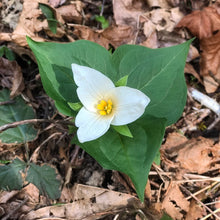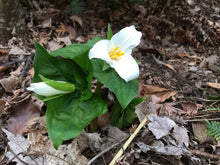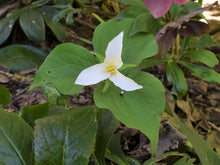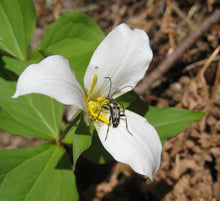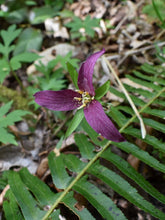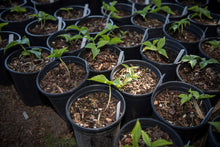
Trillium ovatum
Western trillium is a distinct, stunning wildflower celebrated across the Pacific Northwest, including at Tryon Creek's Trillium Festival. Bulbs announce spring each year with a triplet of leaves topped by bright white flowers that illuminate the woodland garden in April, then fade from pinks, to purples and eventually brown before withdrawing completely back to the bulb to wait for next year. This is a slow growing but exceptionally long-lived plant, stemming from rhizomes and creating a larger clump with more abundant blooms over many years.
- Plant type/canopy layer: deciduous, perennial, herbaceous plant
- Size at maturity: 4-18", 6-24" wide
- Light requirements: full shade, part-sun/part-shade
- Moisture requirements: moist soil, well-drained
- Bloom time: March - July (March - June in the Portland Metro area)
- Growth rate/ease: grows slowly, moderately difficult to grow
- Wildlife support: flowers attract and support bees, particularly the bumble bees that pollinate it, and other insect pollinators; overall plant attracts and supports beneficial and pest eating insects
- Native habitat/range: common in mixed forests across most of the Pacific Northwest from the Cascades to the coast. Portland Plant List - yes.
- Special features & uses: medicinal; landscape uses include woodland gardens, shady pollinator gardens and shady raingardens
What to Expect + Gardening with Western Trillium: Trillium is one plant where the right conditions truly matter. You'll enjoy watching it thrive in moist, acidic soils that contain lots of organic matter, such as a mature forest garden where leaf litter and woody materials are left in place.
For spring orders, depending on the weather and the date of your order pick-up, bulbs may be just emerging or already dying back for the season. Bulbs can be fragile when they're actively growing in spring. So, either plant with care or keep it in its pot and wait until it dies back before planting. By early summer, the plant will die back completely and the bulb will be easy to transplant. If you go this route, leave the pot in a sheltered place and water sparingly, so that you don't rot the bulb. For fall orders, you can expect what looks like a pot of dirt. The bulb inside may appear slightly shriveled, which is its normal, dormant fall look. Fall is generally considered an excellent time to plant bulbs.
Like many bulbs, be sure the soil is moist but well draining, so the bulb doesn’t rot. Trilliums can withstand minor summer drought, but supplemental water in the summer is necessary for the first few years after it’s transplanted. Admire its blooms in nature, not in a vase - as picking them will significantly diminish the plant, often eliminating blooms for several years! It is also adored by slugs.
Like many native plants in the Lily Family, the berry-like fruits evolved to have a fleshy appendage called elaiosomes that are both attractive and nutritious for ants. These tiny workers haul the seed back to their underground nests to feed the elaiosomes to their young, and leave the remaining seed embedded in their underground nests. In doing so, they are critical players in a magical dance of seed dispersal that mutually benefits both the plants and the ants. So, think twice next time you reach for that outdoor ant killer.
Photo Credit 1: Tara Lemezis, Tiny Seed Photography
Photo Credits 2, 3, 5: Tracy Cozine & Nikkie West, Sparrowhawk Native Plants
Photo Credit 4: "Trillium ovatum with Pollinator" by brewbooks is licensed under CC BY-SA 2.0.
Photo Credit 5: Hoddick Photography






